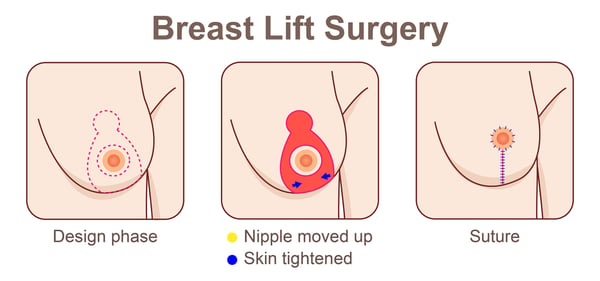Aesthetic Procedures: Breast Lift Mastopexy
⦁ Grade 1: Nipple at inframammary fold (IMF)
⦁ Grade 2: Nipple between IMF and lowest point of breast
⦁ Grade 3: Nipple at lowest point of breast
⦁ Pseudoptosis: Nipple above IMF but majority of breast tissue is below the IMF
How is a breast lift performed?
The breast tissue, otherwise known as the parenchyma, is also mobilized, whilst maintaining its blood supply, to reinforce the breast lift and give it longevity. These cuts are made on the inside of the breast and you will not be able to see them. There is a low risk of reduced nipple sensation and most patients can breastfeed again after the procedure.
In some cases, the deflation in the breast leads to a large loss of volume together with sagging skin. This can be addressed in a breast augmentation-mastopexy procedure, where an implant is used to restore volume and the mastopexy is used to tighten the native breast envelope.

What is a breast lift?
Breasts commonly deflate and become droopy after breastfeeding, weight loss or ageing. A breast lift procedure is a procedure to help permanently shift droopy breast tissue, nipple as well as areolar to a “higher”, more youthful looking position, much more like how it used to look like before.
Why choose a breast lift?
A breast lift would be able to restore the breasts’ former volume, position and shape, giving the breast a more aesthetic looking appearance, especially with certain clothing and swimwear. It is possible to improve the appearance of the areolar or nipple during the breast lift procedure. At the same time, any form of asymmetry of the breasts would be improved during the procedure as well. This would improve one’s self-confidence and allow improved versatility in terms of wardrobe options.
Are you a good candidate for a breast lift?
You would be a good candidate for a breast lift procedure if you have/are:
- Droopy, deflated breasts that are bothering you
- Completed breast feeding for at least 3 months after pregnancy
- In good health otherwise, maintaining a regular exercise and diet regime
- A non-smoker
- Optimised, well controlled medical condition(s) (do inform your doctor of any medical condition)
How to prepare for a breast lift?
Prior to embarking on your breast lift procedure, be sure to have consulted a board-certified plastic surgeon to discuss a definitive surgical and recovery plan. It is also recommended to have completed a recent breast screening mammogram prior to surgery. To optimise recovery, do remember to inform your plastic surgeon about all the medications and supplements you are taking, as there may be some which need to be stopped prior to surgery. Smoking severely affects outcomes and significantly increases your risk of complications, so it is advisable to quit smoking before considering surgery. Our nurses will be on hand to advise and measure out the suitable compression garments for your surgery. Lastly, once you have worked out your recovery plan, do set aside ample space and time for your recovery, and enjoy the experience.
What does the procedure involve?
What to expect during and after a breast lift?
Prior to the procedure, it is important to have a detailed discussion with your plastic surgeon about the details of your desired procedure. Depending on your current breast size and shape, adjunctive procedures such as the use of fat grafting or breast implants, to improve size, projection and upper pole fill, may be discussed with you. This may in turn affect the type of incisions used and this will all be decided with you prior to surgery.
Breast lift procedure is typically a day surgery procedure.
Post-surgery recovery would be dependent on the procedure chosen, and it would vary from a few days to a few weeks. Most patients could expect their wounds to heal up in a week or two, and gradually return to normal activities from thereon. Simple cardio- or stretching exercises can be started around the 3rd week, strenuous activities and heavy lifting can be gradually resumed after 4-6 weeks, depending on your individual progress.
It is normal to experience swelling, bruising and pain during this recovery phase. Compression garments help to quickly reduce swelling, bruising and pain for the first few weeks. For more extensive types of surgeries, you may be required to care for a small plastic tubing connected to a bottle (also known as a surgical drain). The surgical drain is often used to rapidly reduce swelling, bruising and surgical fluid accumulation under the skin and wounds, and these can be removed in the clinic after some time.
Risks and complications
- Bleeding: If severe, it may require a second operation to evacuate/stop
- Infection: Antibiotics will be given to you post-operatively to minimize this
- Bad scarring: Scar management is instituted early to minimize this
What are the possible complications and side effects of a breast lift?
Some complications that could occur include bleeding, infection and wound dehiscence (or gapping of the wound). Rarely, some patients may experience collection(s) of fluid (seroma) or blood (hematoma) which may require addressing. It is also crucial to communicate with your plastic surgeon about your surgical goals or targets before any surgery, so that all your needs and expectations can be addressed adequately. Sometimes, there may be numbness of the nipple-areolar region, which is transient for most of the time. Lastly, long term scarring after surgery can be minimized through optimal surgical design and technique, but the long-term result can vary greatly between individuals. Overall, the complication rate would be related to the complexity of the surgery.
How much does a breast lift cost?
If a breast reduction (LINK) is what suits your clinical situation more, it may be covered by Medisave/Medishield and/or Insurance plan. Do speak with an experienced Plastic Surgeon to find out more.
Experiencing difficulties with the excess, saggy skin and undesirable body contour after childbirth, despite having done your best diet and exercise regulations? Mommy makeover procedures are the most direct and effective way of improving your body contour. Schedule a Consultation to find out more.
PATIENT STORIES
Post Massive Weight Loss Body Contouring
A 40-year-old lady consulted with Dr Pek with the desire to correct large amounts of excess skin and soft tissue. She had undergone Bariatric Surgery (Sleeve Gastrectomy) 2 years prior to her presentation and had successfully lost almost 30kg of weight. With ... Read more
Treat Gynecomastia with Minimally Invasive Methods in Singapore
A 38-year-old male engineer presented to Dr Pek with symptomatic growth of his chest/breast area. Since puberty, he complained of unusually prominent chest tissue around his nipple and areolar region. This had worsened gradually over the years, with the left ... Read more
Upper eyelid lift and eyebags rejuvenation
63 years old Chinese female with hypertension and hyperlipidemia presented to Dr Pek with significant droopiness of her upper eyelids on both sides, affecting the upper portion of her visual field. She would constantly feel that her upper eyelids were heavy, ... Read more
Bilateral breast reconstruction using abdominal free flaps
A 45-year-old mother of 2 children was diagnosed with left breast cancer, for which a skin-sparing mastectomy (total removal of breast tissue leaving behind the skin envelope) was recommended. Read more
ARTICLES
TL;DR: A tummy tuck (abdominoplasty) goes beyond aesthetics ...
TL;DR: Lymphedema is long-term swelling caused by poor ...
Contact Form
1 Orchard Boulevard #10-08 Camden Medical Centre, Singapore 248649
6 Napier Rd, #08-01 Gleneagles Medical Center, Singapore 258499
Tel: +65 6737 4565 | Mobile: +65 8828 4565 | Email: clinic@polarisplasticsurgery.com | Business Hours: Mon - Fri: 9am - 6pm | Sat: 9am - 1pm | Sun/Ph: Closed












